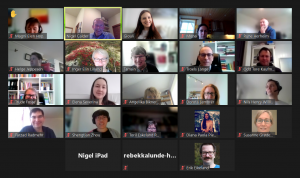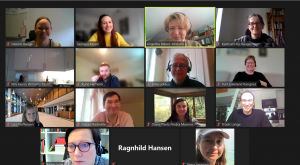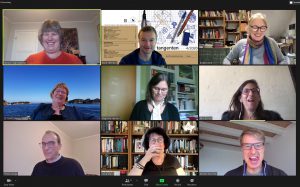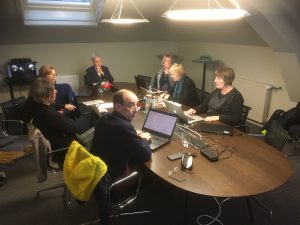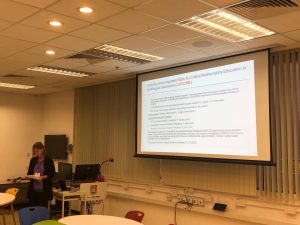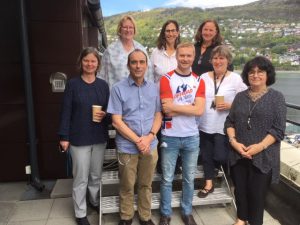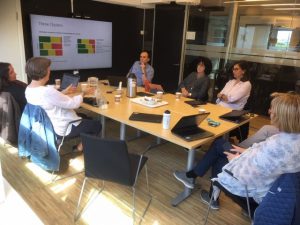– Στις 12 Μαΐου παρουσίασα μια εργασία με αρχικά αποτελέσματα της μελέτης μου στο πλαίσιο της διδακτορικής μου διατριβής. Είχα υποβάλλει το κείμενο της εργασίας σε επιστημονικό συνέδριο και έλαβα δύο αξιόλογες κριτικές με θετικό πρόσημο. Το θέμα της εργασίας είναι «Πρακτικές στην εκπαίδευση των εκπαιδευτικών για την υποστήριξη των μελλοντικών εκπαιδευτικών στην γλωσσικά-ανταποκρινόμενη διδασκαλία της μοντελοποίησης». Σχετίζεται με το μέρος «εφαρμογής» των πρακτικών μου ως εκπαιδευτικός εκπαιδευτικών. Καθότι το διδακτορικό μου πρότζεκτ είναι μία έρευνα-δράσης, δράττομαι ακόμη περισσότερο της ευκαιρίας που μου δόθηκε να συμμετάσχω στα σεμινάρια και να συζητήσω με συναδέλφους, και σαφώς να αξιοποιήσω τον χώρο που μου αφιερώνεται στο ιστολόγιο ως καταλητικό μέρος της διαδικασίας δράσης και ανταστοχασμού.
Είχα πλαισιώσει την παρουσίασή μου γύρω από μια ατζέντα κεντρικών ερωτημάτων Keep reading - Greek!
του
τι,
γιατί και
πώς διερευνάται το εν λόγω θέμα, συνεχίζοντας με το
και μετά τι,
και τώρα τι, αντλώντας έμπνευση από το μοντέλο της σκάλας συμπερασματολογίας. Το ενδιαφέρον μου στρεφόταν ιδιαίτερα στο να βελτιώσω το ερώτημα του
και τώρα τι, ως προς το τι σημαίνουν τα ευρήματά μου για τις πρακτικές ενός εκπαιδευτικού εκπαιδευτικών, και ποια είναι η άποψη των συναδέλφων μου για τους τρόπους που έχω ερμηνεύσει τα δεδομένα σχετικά με τις περαιτέρω συνέπειες πρακτικών στην εκπαίδευση και έρευνα των εκπαιδευτικών.
Θεώρησα την όλη διαδικασία του σεμιναρίου ωφέλιμη για τη δουλειά μου: την προετοιμασία, την ίδια τη δράση της παρουσίασης, και στη συνέχεια τη συζήτηση με τους/τις συναδέλφους.
Καταρχάς, η προετοιμασία για την παρουσίαση με έκανε να σκεφτώ καλύτερα το πώς μιλώ και επικοινωνώ στους άλλους την δουλειά μου. Όντας μη φυσική ομιλήτρια της αγγλικής και της νορβηγικής γλώσσας, έχω κληθεί πολλές φορές να αντιμετωπίσω τις προκλήσεις της επικοινωνίας όταν οι υπόλοιποι συμμετέχοντες δε μοιράζονται την μητρική μου γλώσσα. Γνωρίζοντας πως θα μπορούσα να αφιερώσω περίπου 45 λεπτά για την παρουσίαση πριν το άνοιγμα της συζήτησης προς το κοινό, ήταν σαφώς ένα μεγάλο πλεονέκτημα. Πρώτον, μου έδωσε τη δυνατότητα να αισθανθώ πιο άνετα και ελεύθερα για να απευθυνθώ σε ένα διεθνές κοινό, συγκριτικά με τον συνηθισμένο χρονικό περιορισμό των 10-20 λεπτών, και έτσι να εστιάσω την προσοχή μου στο τι πρέπει να ειπωθεί από την μεριά μου, αντί για το πώς ακριβώς πρέπει να γίνει αυτό. Δεύτερον, μου επέτρεψε να εμβαθύνων σε κάθε ένα από τα κεντρικά ερωτήματα, όπως προαναφέρθηκαν στην προηγούμενη παράγραφο, όχι ξεχωριστά το ένα με το άλλο, αλλά συνδετικά μεταξύ τους.
Συγκεκριμένα, έπιασα τον εαυτό μου να αναρωτιέται: Είναι η συλλογιστική μου αρκετά ισχυρή για να χτίσει τη μελέτη μου; Πώς μπορώ να την βελτιώσω; Τι πρέπει να προσαρμόσω για να του δώσω περισσότερο νόημα και να το κάνω πιο κατανοητό για το κοινό μου, γνωρίζοντας πως οι συνάδελφοί μου έχουν ένα ισχυρό(τερο) μαθηματικό υπόβαθρο και ενδιαφέρον για τη μαθηματική εκπαίδευση και τη μοντελοποίηση; Τι θα ήθελα να μάθω από αυτούς; Ποιο είναι το πιο αδύναμο σημείο της μελέτης μου μέχρι τώρα; Υπάρχουν τυφλά σημεία ή περιορισμοί της μελέτης που δεν είχα σκεφτεί πριν;
Για να απαντήσω σε αυτές τις ερωτήσεις και να προετοιμάσω την παρουσίασή μου, χρειάστηκε να επανεξετάσω τα δεδομένα μου (συμπεριλαμβανομένων των απομαγνητοφωνήσεων και των διαφανειών των μαθημάτων), καθώς επίσης και τη βιβλιογραφία που υποστηρίζει το υπόβαθρο της μελέτης μου. Αναλογίστηκα ξανά ως προς τις μεθόδους μου, και ιδιαίτερα το μοντέλο ανάλυσης δεδομένων που επεξεργάζομαι ακόμα και που συνιστά τον άδυναμο κρίκο που με προβλημάτιζε από το ξεκίνημα της έρευνας-δράσης. Έτσι, έπειτα από αυτή τη διαδικασία, και έχοντας κατά νου τον απώτερο σκοπό που σχετίζεται με την συνεισφορά της έρευνας σε άλλους εκπαιδευτικούς εκπαιδευτικών που ερευνούν τις πρακτικές τους, αντιλαμβάνομαι πως έχω βελτιώσει σημαντικά το εργαλείο/μοντέλο ανάλυσης, τον τρόπο που το χρησιμοποιώ και που μιλώ για το πώς το χρησιμοποιώ.
Κατά τη διάρκεια της παρουσίασής μου, αξιοποίησα στο έπακρο την ευκαιρία να μοιραστώ τις ιδέες και τους προβληματισμούς μου σε βάθος, καθώς και να αναδείξω σημαντικό μέρος του πώς οραματίζομαι την μελέτη μου. Έτσι, ξέφυγα λίγο από το γραπτό κείμενο του άρθρου και το εμπλούτισα με εικόνες, γραφήματα και χρώματα.
Στη συζήτηση που ακολούθησε, οι συνάδελφοί μου σχολίασαν την επιστημονική σημαντικότητα της μελέτης μου και τη συνάφειά της με την κοινότητα των εκπαιδευτών εκπαιδευτικών εντός ή εκτός του HVL, εφόσον συνδέεται στενά με το πρόγραμμα σπουδών και τους στόχους του πρότζεκτ LATACME με την έμφαση που δίνεται στη μοντελοποίηση και στην πολυγλωσσία. Τα σχόλια των συναδέλφων μου με έκαναν να συνειδητοποιήσω ότι παρόλο που η μελέτη είναι ένα μικρό μέρος τριών μαθημάτων μιας έρευνας, έχει ιδιαίτερη συμβολή στην περιορισμένη προηγούμενη έρευνα που υπάρχει.
Η επιβλέπουσα καθηγήτρια και κριτική μου φίλη με ρώτησε για το πώς συμβάλλουν οι αναστοχασμοί μου στην όλη διαδικασία της έρευνας-δράσης: Πώς με βοηθούν; Πώς διαχειρίζομαι την διαδικασία δεδομένου του λιγοστού χρόνου μεταξύ μαθημάτων; Επιπλέον, σχολίασε το πώς διαχειρίζομαι και κατορθώνω εν τέλει να αναδείξω παραδείγματα από όλο το εύρος των πρακτικών, αντί να κρύψω πρακτικές που μπορεί να μοιάζουν «κακές». Ένα από τα σχόλια που με οδήγησαν να προβληματιστώ ως προς ζητήματα ισότητας όσον αφορά στις δικές μου πρακτικές, ήταν η επιβλέπουσά μου με συμβούλεψε να προσέχω τις συγκρίσεις που μπορεί να κάνω μεταξύ των μαθημάτων που μπορεί να υποννοούν πως τα μαθήματα διά ζώσης είναι «καλύτερα» ή πιο «πολύτιμα» από τα μαθήματα που γίνονται ψηφιακά.
Στη συνέχεια προχωρήματα σε συζήτηση βάσει των κριτικών που εξέλαβα στην εργασία μου για το συνέδριο, και καταλήξαμε στην ανάγκη να ενισχύσω τα εξής: α) τη θέση μου σε αντιπαράθεση με άλλες προσεγγίσεις στο πεδίο, όπως η γλώσσα-ως-πηγή και η διαγλωσσικότητα, και β) το υπόβαθρο της σημασίας της χρήσης μεθόδων έρευνας-δράσης ως εκπαιδευτής εκπαιδευτικών για το συγκεκριμένο θέμα που μελετά την γλωσσικά-ανταποκρινόμενη διδασκαλία των μαθηματικών.
Τώρα, στη μετα-φάση του σεμιναρίου, είμαι ικανοποιημένη και σίγουρη για όσα έχω αποκομίσει μέσα από την συμμετοχή μου στο σεμινάριο και από τον διάλογο με τους/τις συναδέλφους μου. Είμαι ιδιαίτερα ευγνώμων για τα σχόλια των συναδέλφων μου και σίγουρα θα τα λάβω υπόψη για να βελτιώσω την έρευνα-δράση μου. Εφόσον μια έρευνα-δράσης δεν αφορά στο αν κάνεις αυτό που λες ότι (θα) κάνεις, αλλά αν λες αυτό που κάνεις, βρίσκομαι να εμβαθύνω σε ερωτήματα γύρω από όλο το πρότζεκτ μου: Λέω, πράγματι, αυτό που κάνω; Με άλλα λόγια, λέω την αλήθεια; Θα την αναζητήσω! 🙂
-Γιούλη Κ.
– On the 12th of May I presented a paper with initial results of my work for my PhD project. The paper was submitted to a conference and received acceptance reviews from two reviewers. The subject of the paper is “Practices in teacher education for supporting pre-service teachers in language-responsive teaching of modelling”. It concerns the implementation part of my own practices as a teacher educator. Since my PhD project is an action-research project, I seize even more upon the opportunity to participate at the seminar series and discuss with colleagues, and certainly to utilise the space in the blog as crucial part to my action-reflection process.
I framed my presentation around an agenda of central questions of Keep reading - English!
the
what,
why’s and
how’s of the topic, followed by the
then what, and the
now what, inspired by the ladder of inference model. I was particularly interested in improving the
now what question, in terms of what do my findings mean for a teacher educator’s practices, and what do my colleagues think about the ways I have interpreted the data with regard to implications for further practice in teacher education and research.
I found the whole process of the seminar beneficial for my work: the preparation, the action, and the follow-up discussion with my colleagues.
First of all, preparing for the presentation allowed me to reflect on how I language about my work. As a non-native English or Norwegian language speaker, I have found it challenging to communicate my ideas in a sensible way for an audience not sharing my mother tongue. Knowing that I would have about forty-five minutes to present before opening up to the audience, was a great advantage. Firstly, it allowed me to relax and feel more freedom about speaking to an international audience, compared to being in a rush of the usual time-blocks of 10-20 minutes, and so to focus on what needs to be said, instead of exactly how it should be said. Secondly, it allowed me to deepen into each one of the central questions, as I mentioned in the above paragraph, not separately, but also in connection to each other.
In particular, I found myself wondering: Is my rationale strong enough to build up my work? How can I improve it? What do I need to adapt to make it more meaningful and understandable for my audience, knowing that my colleagues have a strong(er) mathematical background and an interest in mathematics education and modelling? What would I like to learn from them? What is the weakest point of my study so far? Are there any blind-spots or limits of my study that I had not previously thought of?
To answer those questions and prepare my presentation, I needed to revisit my data (including both the transcripts and the lesson slides), and the literature that supports the background of my work. I rethought about my methods, and especially the data analysis model that has been under development and the weakest link that I have been trying to strengthen in my action-research process since I started. Therefore, after this process, and being mindful of the purpose related to contributing to other teacher educators’ researching their practices, I consider that I have made improvement on the analytical tool/model, on how I use it, and how I talk about how I use it.
During my presentation, I relished the opportunity to share my ideas and my concerns in deep, as well as to illustrate important parts of how I visualise my work. Therefore, I drifted a little bit from the text in the paper, and enriched it with pictures, charts, and colors.
In the discussion that followed, my colleagues commented on the scientific importance of my work and its relevance to the community of teacher educators inside or outside of HVL, as it links to the curriculum and supports the aims of LATACME with a focus on modelling and multilingualism. My colleagues’ comments made me realise that even though the study is a small part with 3 lessons of a research, it has a lot to contribute to the very little previous research that has been done. My supervisor and critical friend asked about the contribution of the reflections part of my action-research process. How does it help me? How do I manage with the little time I have in between lessons? In addition, she commented upon how I manage being good in raising all sorts of practices and not covering what might look “bad”. One of the comments that challenged me to think about issues of equity in regard to my own practices, was when my supervisor advised me to be mindful of what comparisons I do between the lessons, and assumptions of physical lessons being “better” or more “valuable” than the digital.
We then went into a discussion based on the reviews that I received on my paper, and concluded in the need to strengthen two things: a) my position in respect to other approaches in the field, including language-as-resource and translanguaging, and b) the background of the significance of a teacher educator using action-research methods for this particular kind of study about language-responsive mathematics teaching.
Now, in the meta- process of the seminar, I am happy and certain about the outcomes and the things I have gained from participating and being in a dialogue with my colleagues. I am very thankful for my colleagues’ comments and I will certainly take them into account in order to improve my action-research work. If an action-research is not about whether you do what you say, but whether you say what you do, I am now left wondering in deep about my whole project: Am I saying what I do? In other words, am I saying the truth? Ι commit to search for it.
-Giouli K.
